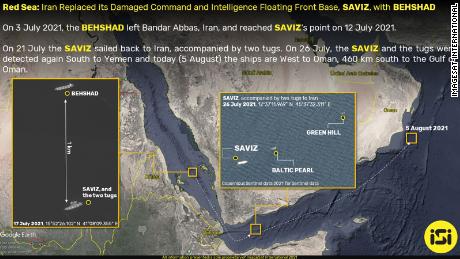Iran towed the stricken vessel back to port and brought in a similar vessel to gather intelligence in the strategically crucial waterway, the officials said.
The Behshad, an Iranian ship registered as a general cargo vessel, left the port of Bandar Abbas in early July, reaching its destination nine days later, according to satellite imagery provided to CNN in a report from ImageSat International, an Israeli satellite and intelligence company, which tracked the ship’s journey. The Behshad stopped near the Bab el-Mandeb strait, a crucial waterway that controls access to the Red Sea and the Suez Canal.
A few days later, the Saviz, another Iranian ship registered as a cargo vessel that had been patrolling those waters for five years, began its journey back to Iran, accompanied by two tugs. The ships are currently south of Oman, satellite images from ImageSat International show.
On Thursday, Israeli Defense Minister Benny Gantz responded “yes” when asked by Israeli media outlet Ynet whether Israel was ready to attack Iran, though Gantz and other Israeli officials have stressed the need for a united diplomatic front against Tehran.
Saeed Khatibzadeh, the spokesman for Iran’s foreign ministry, wrote on Twitter on Thursday that any Israeli military action against the country would be met with a “decisive” response. Khatibzadeh called the Israeli threat of military action a “brazen violation of international law” and warned, “don’t test us.”
Through listed as a cargo ship, the Saviz was used by Iran’s Revolutionary Guard Corps to gather intelligence in the critical waterway and assist Iran’s Houthi allies in Yemen, the officials said. Both the Saviz and the Behshad were sanctioned by former President Donald Trump in 2018 as part of his maximum pressure campaign on Iran.
The Saviz sustained damage in an early April limpet mine attack believed to be carried out by Israel. Since 2016, the 570-foot ship patrolled the waters near the Bab el-Mandeb strait. Iran has said the ship provided maritime security and operated against pirates.
The attack with the limpet mine, which is an explosive attached to the side of a ship, often just below the water line, came as international negotiators were making progress on a return to the Iranian nuclear deal, known as the Joint Comprehensive Plan of Action (JCPOA), which Israel openly opposes.
The maritime shadow conflict between Iran and Israel reached new heights last week with the drone attack on the Mercer Street, a LIberian-flagged tanker with ties to an Israeli shipping billionaire. A Romanian and a Briton were killed in the attack off the coast of Oman, which the US, UK and others have blamed on Iran. Though Iran has denied any involvement in the attack, the US has called for a coordinated response against Tehran.
Iran’s actions in open waters have grown increasingly brazen. This week, Iranian gunmen seized the Asphalt Princess off the coast of the United Arab Emirates for a number of hours.
“We are looking into the incident, but do not have an understanding of what the Iranians were doing at this time, or why they would impede the transit of this legitimate commercial vessel,” US Central Command spokesman Capt. William Urban told CNN.
The White House warned that Iran’s “escalating activity” is a concern to the US and the international community.
“We feel it follows a pattern of attacks and other belligerent behavior,” White House press secretary Jen Psaki said Thursday. “And these actions also threaten freedom of navigation through crucial waterways — something that is posing a risk to a range of countries around the world.”
At least three times in recent months, Iranian fast attack boats in the Persian Gulf have approached US Navy and Coast Guard vessels, closing to within a few dozen yards in what officials described as “unsafe and unprofessional maneuvers.” In one of the incidents in May, a Coast Guard vessel fired approximately 30 warning shots when the fast attack boats failed to acknowledge bridge-to-bridge radio transmissions and other means of communication.






